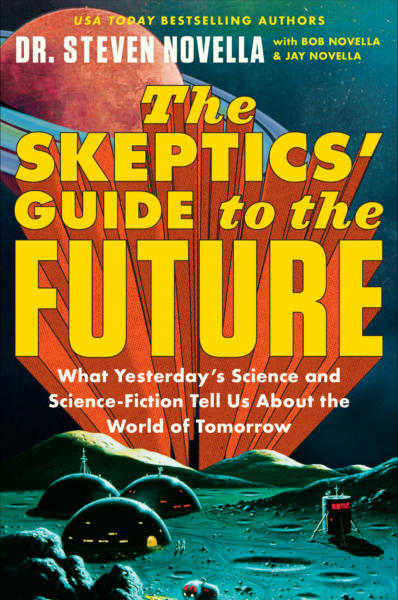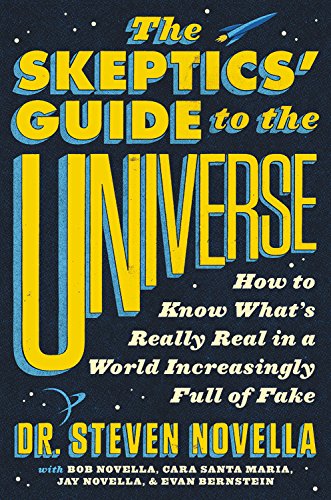Aug
13
2024
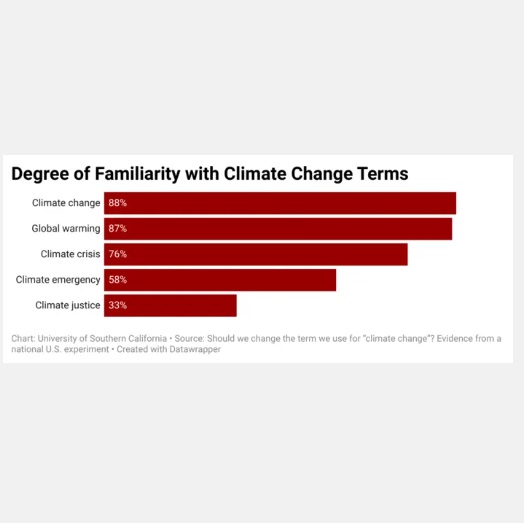 When we talk publicly about the effects of human activity on the climate should we refer to “global warming”, “climate change”, the “climate crisis” or to “climate justice”? Perhaps we should also be more technical and say specifically, “anthropogenic climate change”. This kind of question is often referred to as “framing”, meaning that we need to be thoughtful about how we frame topics for science communication and open discussion.
When we talk publicly about the effects of human activity on the climate should we refer to “global warming”, “climate change”, the “climate crisis” or to “climate justice”? Perhaps we should also be more technical and say specifically, “anthropogenic climate change”. This kind of question is often referred to as “framing”, meaning that we need to be thoughtful about how we frame topics for science communication and open discussion.
I remember about two decades ago when the concept of “framing” was really introduced into the skeptical community. There was a lot of pushback, because the practice was considered to be deceptive, and more aligned with political persuasion than science communication. This criticism was unfounded, in my opinion, largely because it is naive. It assumes, falsely, that you can communicate without framing. In reality you are framing your messages whether you know it or not, so you might as well be conscious and thoughtful about it.
To get into more detail, what is meant by framing is the overall approach to a topic in terms of major perspectives and considerations. For example, we can frame a discussion on GMOs as purely a scientific question – what does the evidence say about the risks and benefits of genetic engineering technology? We can also frame the topic as one of regulation – how should governments regulate GMOs? Or we can focus on corporate behavior and power. Often, the explicit framing I take on this blog, the framing focusses on critical thinking, pseudoscience, and conspiracy theories. How do we think logically and make sense of all the claims and information?
Continue Reading »
Aug
12
2024
 The cultural effects of the COVID pandemic can still be felt reverberating through society. One of the positive effects, in my opinion, was the sudden boost to remote technology – connecting remotely for meetings and other uses through Zoom or a similar application. This development has been a little controversial, but I think on the whole has been a net positive, especially as we move into the era of voluntary remote connections and hybrid meetings.
The cultural effects of the COVID pandemic can still be felt reverberating through society. One of the positive effects, in my opinion, was the sudden boost to remote technology – connecting remotely for meetings and other uses through Zoom or a similar application. This development has been a little controversial, but I think on the whole has been a net positive, especially as we move into the era of voluntary remote connections and hybrid meetings.
Prior to the pandemic having a hybrid or remote meeting was still the exception rather than the rule. We were slowly progressing in this direction, but it was still uncommon and looked upon with suspicion. For example, my wife obtained her PhD through a hybrid online program (partly online, partly in person). This worked well and was very convenient, considering we live in CT and the program is based in Oregon. But she definitely faced some professional headwinds in terms of acceptance of the concept of online learning. At K-12 schools remote learning was essentially not a thing.
While virtual meetings were already a thing, they too were not routine. For me personally, for example, all of my meetings, lectures, rounds, and workshops were in person. There wasn’t even an option to attend remotely. This is despite the fact that we have the technology. Grand rounds, for example, was streamed to an outside location where some of our physicians work so that they could attend.
Clinically there was a lot of discussion about virtual office visits, and again we saw the beginnings of this technology and very tentative explorations. Mostly this was used to provide expert-level consultations to remote areas or local hospitals lacking such experts. For routine use, however, it was non-existent, and there were many bureaucratic obstacles, such as state licensing rules and insurance reimbursement.
Continue Reading »
Aug
09
2024
 Both Lin Yu-ting of Taiwan and Imane Khelif of Algeria earned medals in female boxing competition at the 2024 Olympics. This has caused a controversy because both boxers, according to reports, have some form of DSD – difference of sex development. This means they have been caught up in the culture war regarding trans athletes, even though neither of them is technically trans. What is the science here and how should sporting competitions like the Olympics deal with it?
Both Lin Yu-ting of Taiwan and Imane Khelif of Algeria earned medals in female boxing competition at the 2024 Olympics. This has caused a controversy because both boxers, according to reports, have some form of DSD – difference of sex development. This means they have been caught up in the culture war regarding trans athletes, even though neither of them is technically trans. What is the science here and how should sporting competitions like the Olympics deal with it?
Both female boxers have XY chromosomes (according to the IBA). For some people this means they are male, but as is often the case, it’s more complicated than that. Let’s quickly review some basic biology regarding biological sex to put this into perspective.
Male-Female develop does begin with sex chromosomes: XX for female and XY for male. Specific genes on the X and Y chromosomes affect sexual development, partly through production of sex hormones such as estrogen and testosterone. XX individuals develop ovaries and eggs, produce high estrogen and low testosterone, and develop anatomically along a typical female path with uterus, vagina, and with puberty, female secondary sexual characteristics. XY individuals develop gonads and sperm, make high testosterone, and develop along a typical male path with descended testes, penis and with puberty, male secondary sexual characteristics. All of this is part of biological sex. But also there is the potential for differences every step of the way. In addition, there are other chromosomal arrangements possible. By some estimates about 1 in 300 people have some difference of sex development.
Continue Reading »
Aug
08
2024
 About half of Americans, when asked, report that they don’t read the user manual for new technical devices they acquire. Although I suspect that many people are like me – I read them sometimes, and then only partly. If there is a “quick user guide” I will often look at that. These are helpful quick summaries with just the critical bits of information you need. But often I give it a go by myself and then only consult the guide for troubleshooting. I do this partly because I want to see how intuitive the device or app is.
About half of Americans, when asked, report that they don’t read the user manual for new technical devices they acquire. Although I suspect that many people are like me – I read them sometimes, and then only partly. If there is a “quick user guide” I will often look at that. These are helpful quick summaries with just the critical bits of information you need. But often I give it a go by myself and then only consult the guide for troubleshooting. I do this partly because I want to see how intuitive the device or app is.
But of course there are situations where this approach is not adequate, especially when assembling something complex or using an entirely unfamiliar and complicated piece of technology. In these situations I find, most of the time (with a few happy exceptions) that the instructions are terrible. Sometimes they were clearly written by someone for whom English is a second language. Or the instructions are entirely pictoral (I guess to be language neutral). Other times it seems they were written by engineers who lack the ability to communicate effectively their arcane craft to the general public. I think this is why many people try to bypass the instructions – they are often terrible and frustrating.
In industry, however, this option may not exist. Further, the instructions may need to be highly technical, which is great if you are already an expert but may be challenging for most users.
This is where artificial intelligence enters the picture. Large language model AIs, like Chat GPT, can “read” material and then answer questions about that material, or even give a summary. I have used Chat GPT to analyze a scientific study, then asked it to find specific information within the study or explain certain findings, and it does pretty well. The idea, therefore, is to feed an entire technical user manual into an LLM and then ask it specific questions or have it give a summary or perhaps step-by-step guide.
Continue Reading »
Aug
01
2024
 Let me start out by saying that I think the answer to that question is no – but this requires lots of clarification. This was, however, the discussion here, while although poorly informed, does raise some interesting questions. This is a Tik Tok video of a popular podcast which is mainly personalities chatting. The host, Logan, asks the question of whether or not it is possible that Jesus was essentially a con artist – a charismatic speaker who essentially started a cult of personality, and may or may not have believed his own rhetoric about being the son of God.
Let me start out by saying that I think the answer to that question is no – but this requires lots of clarification. This was, however, the discussion here, while although poorly informed, does raise some interesting questions. This is a Tik Tok video of a popular podcast which is mainly personalities chatting. The host, Logan, asks the question of whether or not it is possible that Jesus was essentially a con artist – a charismatic speaker who essentially started a cult of personality, and may or may not have believed his own rhetoric about being the son of God.
I think the question touches on something interesting, although historical context is critical. As I have discussed before, I think the evidence for a historical Jesus is thin. In the end, it doesn’t really matter because what is clear is that the mythology of Jesus evolved in a typical way involving all the elements known to fuel such mythologies. There were many stories of Jesus which are mutually exclusive, involving wildly different archetypes and story details. The themes followed the mythology themes that were already prominent in that time and place. The story evolved in a pattern of obvious embellishment. Eventually a canon was imposed from the top down, and all other versions became heresy and actively destroyed. What is left is almost entirely mythology, and the question of whether or not the life of a real person is in the mix is mostly irrelevant (from a historical point of view).
Unfortunately this renders the Logan conversation mostly irrelevant also, one giant non sequitur. Everyone in the conversation assumes that the details in the New Testament are historically accurate (if not the interpretation of those details), but that assumption is not justified. So the conversation takes the form of – could those details be the result of a charismatic con artist, or do they require an actual son of God.
Continue Reading »
Jul
30
2024
 The topic of genetically modified organisms (GMOs) is a great target for science communication because public attitudes have largely been shaped by deliberate misinformation, and the research suggests that those attitudes can change in response to more accurate information. It is the topic where the disconnect between scientists and the public is the greatest, and it is the most amenable to change.
The topic of genetically modified organisms (GMOs) is a great target for science communication because public attitudes have largely been shaped by deliberate misinformation, and the research suggests that those attitudes can change in response to more accurate information. It is the topic where the disconnect between scientists and the public is the greatest, and it is the most amenable to change.
The misinformation comes in several forms, and one of those forms is the umbrella claim that GMOs have been bad for farmers in various ways. But this is not true, which is why I have often said that people who believe the misinformation should talk to farmers. The idea is that the false claims against GMOs are largely based on a fundamental misunderstanding of how modern farming works.
There is another issue here, which falls under another anti-GMO strategy – blaming GMOs for any perceived negative aspects of the economics of farming. Like in many industries, farm sizes have grown, and small family farms (analogous to mom-and-pop stores) have given way to large corporate owned agricultural conglomerates. This is largely due to consolidation, which has been happening for over a century (long before GMOs). It happens because larger farms have an economy of scale – they can afford more expensive high technology farm equipment. They can spread out their risk more. They are more productive. And when a small farm owner retires without a family to leave it to, they tend to consolidate with a larger farm. Also, government subsidies tend to favor larger farms.
Continue Reading »
Jul
25
2024
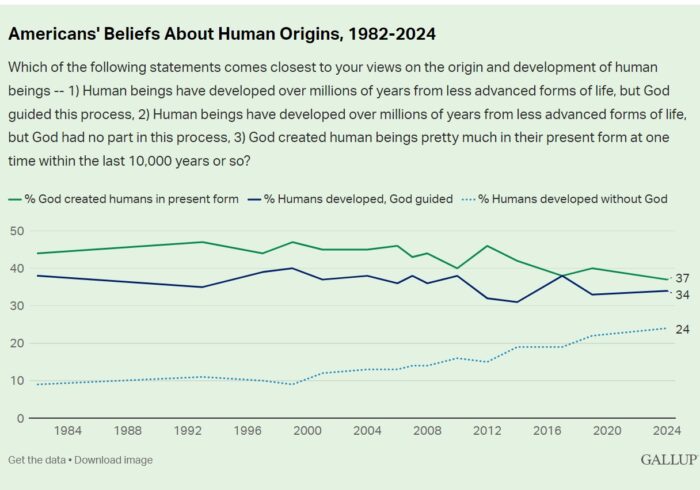 Surveys are always tricky because how you ask a question can have a dramatic impact on how people answer. But it is useful to ask the exact same question over a long period of time, because that can indicate how public attitudes are changing. This is one of the benefits of Gallup, which was founded in 1935 and is dedicated to high quality and representative polls. They have been asking the following question since 1982:
Surveys are always tricky because how you ask a question can have a dramatic impact on how people answer. But it is useful to ask the exact same question over a long period of time, because that can indicate how public attitudes are changing. This is one of the benefits of Gallup, which was founded in 1935 and is dedicated to high quality and representative polls. They have been asking the following question since 1982:
“Which of the following statements comes closest to your views on the origin and development of human beings — 1) Human beings have developed over millions of years from less advanced forms of life, but God guided this process, 2) Human beings have developed over millions of years from less advanced forms of life, but God had no part in this process, 3) God created human beings pretty much in their present form at one time within the last 10,000 years or so?”
It’s an imperfect way to ask these questions – the “less advanced life forms” is not really accurate, and the questions all assume or imply the existence of God. But by asking “which one comes closest” it does capture the essence of this issue. Option 3 is basically young-Earth creationism, option 2 is pure scientific evolution, and option 1 is everything else. From my view as a skeptic and science communicator, the results of this survey are dismal but also encouraging. At the start of the survey in 1982 the numbers were stark: 1 – 38%, 2 – 9%, and 3 – 44% (the rest undecided). Therefore 82% of Americans endorsed some form of creationism, and only 9% were willing to say that life resulted from evolution acting all by itself.
The most recent poll from this perspective is encouraging: 1 – 34%, 2 – 24%, and 3 – 37%. There is still a plurality endorsing young-Earth creationism, but those endorsing scientific evolution is up to 24%. These numbers also track with surveys on religion in the US. The young-Earth creationism figure is about the same as the number of Americans who identify as some kind of evangelical (something between 30 and 39%). Admittedly, this number can be squirrely depending on how you define “evangelical” and ask the question, but broadly defined, the numbers track. The scientific evolution numbers also track with those who answer on surveys that they are religiously unaffiliated, also now in the 20’s.
Continue Reading »
Jul
23
2024
 Often times the answer to a binary question is “yes”. Is artificial intelligence (AI) a powerful and quickly advancing tool or is it overhyped? Yes. Are opiates useful medicines or dangerous drugs? Yes. Is Elon Musk a technological visionary or an eccentric opportunist? This is because the world is usually more complex and nuanced than our false dichotomy or false choice simplistic thinking. People and things can contain disparate and seemingly contradictory traits – they can be two things at the same time.
Often times the answer to a binary question is “yes”. Is artificial intelligence (AI) a powerful and quickly advancing tool or is it overhyped? Yes. Are opiates useful medicines or dangerous drugs? Yes. Is Elon Musk a technological visionary or an eccentric opportunist? This is because the world is usually more complex and nuanced than our false dichotomy or false choice simplistic thinking. People and things can contain disparate and seemingly contradictory traits – they can be two things at the same time.
This was therefore my immediate reaction to the question – are AI companions a potentially healthy and useful phenomenon, or are they weird and harmful? First let me address a core neuropsychological question underlying this issue – how effective are chatbot companions, for just companionship, or for counseling, or even as romantic partners? The bottom line is that the research consistently shows that they are very effective.
This is likely a consequence of how human brains are typically wired to function. Neurologically speaking, we do not distinguish between something that acts alive and something that is alive. Our brains have a category for things out there in the world that psychologists term “agents”, things that are acting on their own volition. There is a separate category for everything else, inanimate objects. There are literally different pathways in the brain for dealing with these two categories, agents and non-agents. Our brains also tend to overall the agent category, and really only require that things move in a way that suggest agency (moving in a non-inertial frame, for example). Perhaps this makes evolutionary sense. We need to know, adaptively, what things out there might be acting on their own agenda. Does that thing over there want to eat me, or is it just a branch blowing in the wind.
Humans are also intensely social animals, and a large part of our brains are dedicated to social functions. Again, we tend to overcall what is a social agent in our world. We easily attribute emotion to cartoons, or inanimate objects that seem to be expressing emotions. Now that we have technology that can essentially fake human agency and emotion, this can hack into our evolved algorithms which never had to make a distinction between real and fake agents.
Continue Reading »
Jul
19
2024
 This kind of abuse of deepfake endorsements was entirely predictable, so it’s not surprising that a recent BMJ study documents the scale of this fraud. The study focused on the UK, detailing instances of deepfakes of celebrity doctors endorsing dubious products. For example, there is this video of Dr. Hilary Jones used to endorse a snake oil product claiming to reduce blood pressure. The video is entirely fake. It’s also interesting that in the video the fake Jones refers only to “this product” – as if the deepfakers made a generic endorsement (ala Krusty the Clown) that could be then attached to any product.
This kind of abuse of deepfake endorsements was entirely predictable, so it’s not surprising that a recent BMJ study documents the scale of this fraud. The study focused on the UK, detailing instances of deepfakes of celebrity doctors endorsing dubious products. For example, there is this video of Dr. Hilary Jones used to endorse a snake oil product claiming to reduce blood pressure. The video is entirely fake. It’s also interesting that in the video the fake Jones refers only to “this product” – as if the deepfakers made a generic endorsement (ala Krusty the Clown) that could be then attached to any product.
This trend is obviously disturbing, although again entirely expected. This use of deepfakes is deliberate fraud, and should be treated as such. Public figures have a right to their own identity, including their name and likeness. Laws vary by country and by state, but most have some limited protections for the use of someone’s name or likeness. In the US, for example, there is a limited “right of publicity” which limits the use of someone’s name or likely for commercial purposes without their permission. This can also extend beyond death, with the estate holding the rights. Even imitating a recognizable voice has been successfully sued.
This means that using a deepfake clearly violates the right of publicity – in fact it is the ultimate violation of that right. There are generally three legal remedies for violations – monetary damages, injunctive relief, and punitive damages.
How good are the deepfakes? Good enough, especially if you are viewing a relatively low-res video on social media. And of course they are only getting better. We cannot wait until deepfakes are good enough to fool most people, right now they are high enough quality to constitute fraud. So what do we do about it?
Continue Reading »
Jul
16
2024
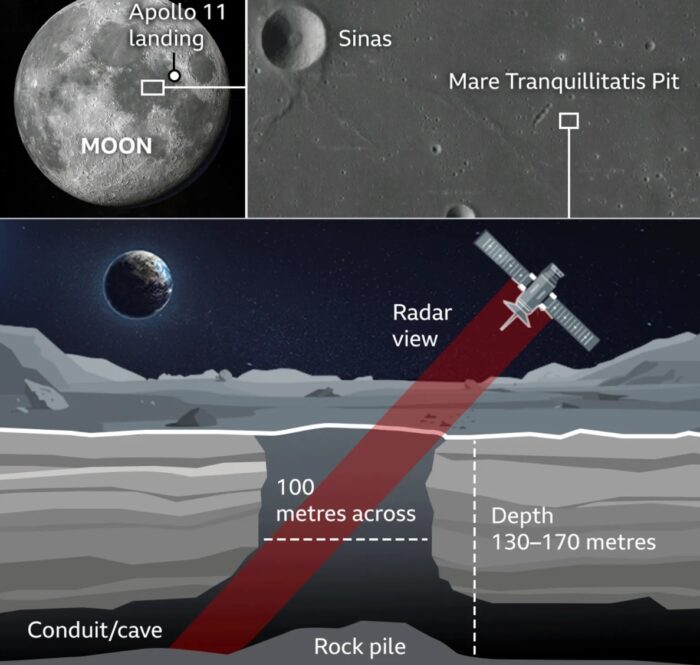 Astronomers have discovered multiple “pits” on the surface of the moon – these look superficially like craters, but on closer inspection are actually vertical pits. There has been considerable speculation that these pits might be cave openings. Now, an analysis of data from the Lunar Reconnaissance Orbiter from 2010 reveals that at least one of these pits is in fact a cave opening.
Astronomers have discovered multiple “pits” on the surface of the moon – these look superficially like craters, but on closer inspection are actually vertical pits. There has been considerable speculation that these pits might be cave openings. Now, an analysis of data from the Lunar Reconnaissance Orbiter from 2010 reveals that at least one of these pits is in fact a cave opening.
The pit is located in the Mare Tranquillitatis, near the site of the Apollo 11 landing (the Sea of Tranquility) and is therefore called the Mare Tranquillitatis Pit (MTP). It is 100 meters across and 130-170 meters deep. The study used radar data at a downward angle which was able to image the sides of the bottom of the pit, showing that there is a possible conduit there for an underground cave system. This conduit is at least tens of meters long, but could be much larger.
While this is exciting, it’s not surprising. One hypothesis is that these lunar pits are “skylights” of underground cave systems, carved out by lava tubes when the Moon was more geologically active. If true, then it’s possible that they are extensive, and can also be quite large. Why is this so exciting?
There are two main reasons NASA and others are interested in lunar caves. One is geological – such cave systems might be billions of years old, and therefore can preserve lunar rocks by protecting them from the radiation and micro meteors that pummel the lunar surface. When we send astronauts back to the Moon (or even just highly capable robots) they could explore these caves and are likely to make some interesting discoveries about the Moon.
But the second application is the most intriguing. I have deliberately buried the lede here, partly because I suspect most readers know where this story is going. Such lunar caves could be ideal locations for future lunar bases. This is for the same reason they are good locations to do some geological investigations on the Moon – the caves are protected. This is something that science fiction shows give very short shrift to, and for this reason perhaps is greatly underappreciated by the public. Space is a very dangerous place, and not just because it’s largely a cold vacuum. Space is full of radiation, and stellar systems are full of fast-moving debris.
Continue Reading »
 When we talk publicly about the effects of human activity on the climate should we refer to “global warming”, “climate change”, the “climate crisis” or to “climate justice”? Perhaps we should also be more technical and say specifically, “anthropogenic climate change”. This kind of question is often referred to as “framing”, meaning that we need to be thoughtful about how we frame topics for science communication and open discussion.
When we talk publicly about the effects of human activity on the climate should we refer to “global warming”, “climate change”, the “climate crisis” or to “climate justice”? Perhaps we should also be more technical and say specifically, “anthropogenic climate change”. This kind of question is often referred to as “framing”, meaning that we need to be thoughtful about how we frame topics for science communication and open discussion.
 The cultural effects of the COVID pandemic can still be felt reverberating through society. One of the positive effects, in my opinion, was the sudden boost to remote technology – connecting remotely for meetings and other uses through Zoom or a similar application. This development has been a little controversial, but I think on the whole has been a net positive, especially as we move into the era of voluntary remote connections and hybrid meetings.
The cultural effects of the COVID pandemic can still be felt reverberating through society. One of the positive effects, in my opinion, was the sudden boost to remote technology – connecting remotely for meetings and other uses through Zoom or a similar application. This development has been a little controversial, but I think on the whole has been a net positive, especially as we move into the era of voluntary remote connections and hybrid meetings. Both Lin Yu-ting of Taiwan and Imane Khelif of Algeria earned medals in female boxing competition at the 2024 Olympics. This has caused a controversy because both boxers,
Both Lin Yu-ting of Taiwan and Imane Khelif of Algeria earned medals in female boxing competition at the 2024 Olympics. This has caused a controversy because both boxers,  About half of Americans, when asked, report that they
About half of Americans, when asked, report that they  Let me start out by saying that I think the answer to that question is no – but this requires lots of clarification. This was, however,
Let me start out by saying that I think the answer to that question is no – but this requires lots of clarification. This was, however,  The topic of genetically modified organisms (GMOs) is a great target for science communication because public attitudes have largely been shaped by deliberate misinformation, and the research suggests that those attitudes can change in response to more accurate information. It is the topic where the disconnect between scientists and the public is the greatest, and it is the most amenable to change.
The topic of genetically modified organisms (GMOs) is a great target for science communication because public attitudes have largely been shaped by deliberate misinformation, and the research suggests that those attitudes can change in response to more accurate information. It is the topic where the disconnect between scientists and the public is the greatest, and it is the most amenable to change. Surveys are always tricky because how you ask a question can have a dramatic impact on how people answer. But it is useful to ask the exact same question over a long period of time, because that can indicate how public attitudes are changing. This is one of the benefits of
Surveys are always tricky because how you ask a question can have a dramatic impact on how people answer. But it is useful to ask the exact same question over a long period of time, because that can indicate how public attitudes are changing. This is one of the benefits of  Often times the answer to a binary question is “yes”. Is artificial intelligence (AI) a powerful and quickly advancing tool or is it overhyped? Yes. Are opiates useful medicines or dangerous drugs? Yes. Is Elon Musk a technological visionary or an eccentric opportunist? This is because the world is usually more complex and nuanced than our false dichotomy or false choice simplistic thinking. People and things can contain disparate and seemingly contradictory traits – they can be two things at the same time.
Often times the answer to a binary question is “yes”. Is artificial intelligence (AI) a powerful and quickly advancing tool or is it overhyped? Yes. Are opiates useful medicines or dangerous drugs? Yes. Is Elon Musk a technological visionary or an eccentric opportunist? This is because the world is usually more complex and nuanced than our false dichotomy or false choice simplistic thinking. People and things can contain disparate and seemingly contradictory traits – they can be two things at the same time. This kind of abuse of deepfake endorsements was entirely predictable, so it’s not surprising that
This kind of abuse of deepfake endorsements was entirely predictable, so it’s not surprising that  Astronomers have discovered multiple “pits” on the surface of the moon – these look superficially like craters, but on closer inspection are actually vertical pits. There has been considerable speculation that these pits might be cave openings. Now,
Astronomers have discovered multiple “pits” on the surface of the moon – these look superficially like craters, but on closer inspection are actually vertical pits. There has been considerable speculation that these pits might be cave openings. Now, 



